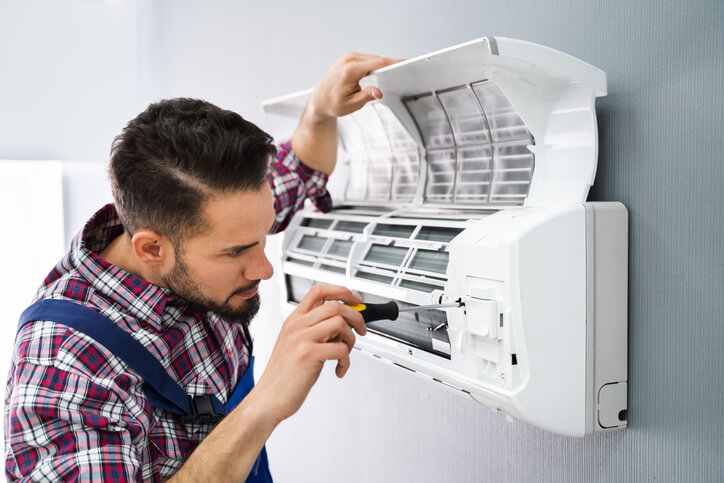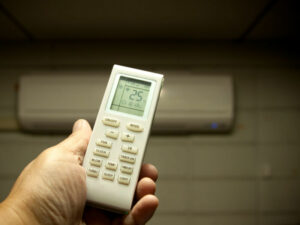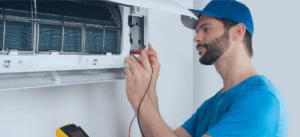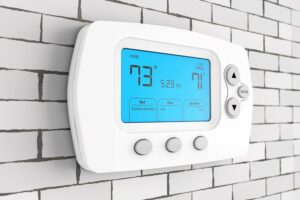An air conditioning system can last for at least 10-15 years with proper maintenance and cleaning. Lack of maintenance can decrease the cooling device’s longevity and increase repair expenses. On the other hand, you can improve the indoor air quality and cooling efficiency if the AC is maintained properly.
Many people think they need an expert’s help for AC maintenance tasks. However, you can perform some D-I-Y maintenance jobs to keep your AC in top-notch condition. Some maintenance tasks like AC leak fixing should be better left to professionals.
You will need some basic tools to clean or change the AC parts. Every homeowner can use these tools without technical knowledge or experience. The cooling device will generate performance issues if you don’t clean or maintain all the units.
So, follow these easy maintenance tasks to avoid a major AC breakdown:
1. Check the Thermostat’s Condition
Start with an easy one! Go to the room where the thermostat is installed and check if it works properly. A broken thermostat can make your house uncomfortably hot or cold. The air conditioning system will also consume more energy if this unit has a problem.
Identifying a faulty AC thermostat is easy. It won’t turn on or display the temperature on the screen if something goes wrong. The batteries might be damaged if you see a black screen. Replacing the battery will restore functionality in the thermostat.
Are you using an old thermostat? Replace it with a smart thermostat to save the energy consumption during hot-humid days. These thermostats let the homeowners regulate the AC temperature from a mobile app. You can also turn on the cooling device via the app if you are near your home.
2. Clean the Dirty Air Filters
Dust, dirt, and grime can accumulate inside the air filters over time, reducing the airflow. Moreover, dirty AC filters can cause severe health issues like allergies, lung infections, and asthma exacerbation. So, you must clean the air filters once a month to avoid these problems.
Turn off the air conditioner before cleaning the filters to avoid electrical hazards. Check the product manual to find the AC filter location. Open the unit and remove the air filters using a screwdriver. Inspect the filter and arrange the cleaning tools like a garden hose and vacuum.
Use a handheld vacuum to remove the debris from this unit. Remove the loose dirt or dust particles from the filters using the garden house. Fill half of the bucket with water and mix 2 cups of white vinegar. Pour this cleaning solution slowly into the air filters for deep cleaning.
Keep the air filters dry and wait for 25-30 minutes. If they are dry, reinstall the AC filters and mount the screws tightly. Turn on your air conditioner and enjoy your room’s cool and allergen-free air.
Should You Replace Your AC Filters?
Some air conditioner filters are not meant to be cleaned, and they must be replaced after a month or two. Turn off your AC and open the vent to remove the disposable air filters. Install the new air filters, and the “Air Flow” arrows must be pointed toward the AC unit. Close the vent and turn on your air conditioning system.
3. Clean the Outdoor Condenser Unit
Most air conditioner condensers are located outside your house. As a result, airborne dust, leaves, and dirt particles accumulate inside this unit, clogging it. Your AC will consume more energy to cool down the room temperature if the condensers are dirty.
Regular cleaning of the outside condenser unit will keep it clog-free, extending its longevity. Wear safety gear like gloves and eye protection before cleaning this unit. Find the electrical box near the condenser and turn it off.
Remove the loose debris from the outside unit using a water hose spray. Additionally, you can use a coil cleaner for an effective condenser cleaning. Wait 10-15 minutes and rinse the cleaner foams with the hose.
4. Keep the Evaporator Drain Clog-free
Your air conditioner’s evaporator drain must be changed at least twice a year – before summer and winter. A clogged drain can cause water dripping issues, damaging your house walls.
If the clog isn’t removed, water will build up inside the condenser or evaporator coil, damaging your AC. Identifying an evaporator drain pipe is easy; it looks like an inch-wide PVC pipe.
It will be located inside the utility drain or near the condenser unit. Use a handheld vacuum cleaner to remove the dust or debris from the evaporator drain. Additionally, you can use a drain snake to unclog the evaporator drain. Also, a chemical cleaner can be used to remove the drain blockages.
5. Look for Blocked AC Vents
It is the easiest AC maintenance task for homeowners. You only need to check all the vents in your cooling system and ensure they aren’t blocked by anything. Blocked air vents can decrease your central AC’s lifespan.
Besides, it can freeze the air conditioning coils, develop leaks in the duct system, and overheat the furnaces. The air vents will collect moisture because the blocked vent, causing mold and mildew growth. So, remove the obstructions from the vent to avoid these air conditioner problems.
6. Clean the Air Conditioner Fins
Fins prevent the air conditioner from overheating by moving the warm air from the unit. Consider keeping the fins clean if you want the cooling device to run efficiently.
However, you should never power wash the fins as they are delicate and can be damaged. Sometimes, air conditioner fins accumulate excess dirt or gunk, which can be challenging to remove with a brush. Use a blunt knife to scrape the debris stick between the fins. Reshape the bent fins with a fin comb after the cleaning.
7. Check all the Electrical Connections
Air conditioner units, including thermostats, can’t run without electricity. Hence, you must inspect all the electrical components during the maintenance.
Turn off the electricity flow and check if the wires have any wear and tear.
Wear safety gloves; don’t touch the electrical units with bare hands. If you see loose electrical wires, contact a professional to fix them.
8. Inspect the Air Conditioner Coils
Ice might build up in the evaporator coil if your AC has a low refrigerant level. The blower fan won’t be able to pull air through the coil, causing overheating issues. Besides, ice can form inside the evaporator coils for refrigerant leaks.
You must inspect these AC units at least once a month during fall and winter. Turn off the air conditioning system and wait until the ice inside the coil melts. Clean the coils with a dry microfiber cloth and remove the blockages to improve the cooling efficiency.
Easy Do-It-Yourself Air Conditioner Maintenance Works for Homeowners
Look for leaks in your air conditioning system ducts. The ducts might be loose or damaged if you hear a rattling or vibrating sound from the AC. Contact AC technicians and replace the ducts before summer.
Additionally, homeowners must inspect and clean the blowers and fans to improve the indoor air quality. It is also imperative to check if the AC unit or heat pump is positioned on the ground level. AC units can malfunction if the ground beneath them tilts. Contact an AC service expert to keep the unit stable if the ground shifts.




